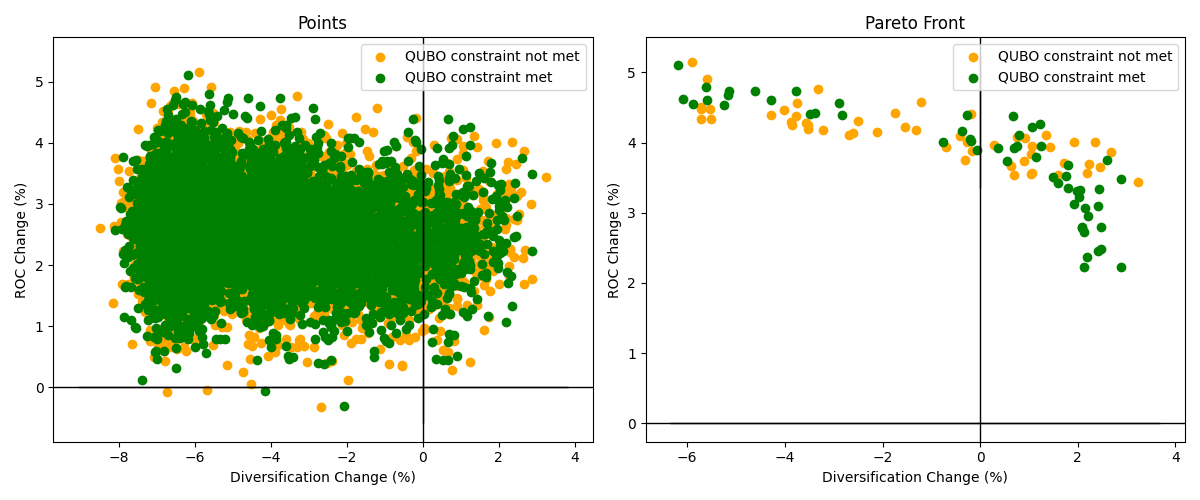Quantum Computing based Portfolio Optimization
Project description
Portfolio optimization
Real-world investment decisions involve multiple, often conflicting, objectives that needs to be balanced. Primary goals typically revolve around maximizing returns while minimizing risks. At the same time, one might want to require additional constraints such as demanding a minimum carbon footprint reduction. Finding a portfolio that balances these objectives is a challenging task and can be solved using multi-objective portfolio optimization.
This repository provides Python code that converts the multi-objective portfolio optimization problem into a QUBO problem. The transformed problem can then be solved using quantum annealing techniques.
The following objectives can be considered
return on capital, indicated byROC,diversification, indicated by the Herfindahl-Hirschman IndexHHI.
Additionally, we allow for a capital growth factor and arbitrary emission reduction constraints to be considered.
The Pareto front, the set of solutions where one objective can't be improved without worsening the other objective,
can be computed for the objectives return on capital and diversification.
The codebase is based on the following paper:
Funding: This research was funded by Rabobank and Stichting TKI High Tech Systems and Materials, under a program by Brightland's Techruption.
Limitations in (end-)use: the content of this software package may solely be used for applications that comply with international export control laws.
Documentation
Documentation of the tno.quantum.problems.portfolio_optimization package can be found here.
Install
Easily install the tno.quantum.problems.portfolio_optimization package using pip:
$ python -m pip install tno.quantum.problems.portfolio_optimization
If you wish to use D-Wave quantum hardware:
$ python -m pip install 'tno.quantum.problems.portfolio_optimization[quantum]'
If you wish to run the tests you can use:
$ python -m pip install 'tno.quantum.problems.portfolio_optimization[tests]'
Usage
Solve portfolio optimization problem.
Here's an example of how the PortfolioOptimizer class can be used to define an portfolio optimization problem,
and subsequently, how the Pareto front can be computed using the simulated annealing sampler from D-Wave.
import numpy as np
from dwave.samplers import SimulatedAnnealingSampler
from tno.quantum.problems.portfolio_optimization import PortfolioOptimizer
# Choose sampler for solving qubo
sampler = SimulatedAnnealingSampler()
sampler_kwargs = {"num_reads": 20, "num_sweeps": 200}
# Set up penalty coefficients for the constraints
lambdas1 = np.logspace(-16, 1, 25, endpoint=False, base=10.0)
lambdas2 = np.logspace(-16, 1, 25, endpoint=False, base=10.0)
lambdas3 = np.array([1])
# Create portfolio optimization problem
portfolio_optimizer = PortfolioOptimizer("benchmark_dataset")
portfolio_optimizer.add_minimize_hhi(weights=lambdas1)
portfolio_optimizer.add_maximize_roc(formulation=1, weights_roc=lambdas2)
portfolio_optimizer.add_emission_constraint(
weights=lambdas3,
emission_now="emis_intens_now",
emission_future="emis_intens_future",
name="emission"
)
# Solve the portfolio optimization problem
results = portfolio_optimizer.run(sampler, sampler_kwargs)
Visualize results.
The results can be inspected in more detail by looking at the Pandas results DataFrame
results.results_df.
Alternatively, the results can be plotted in a (Diversification, ROC)-graph. The
following example first slices the results in data points that do and do not satisfy the
constraints using the method slice_results.
Note that:
- Individual data points can subsequently be plotted using the
plot_pointsfunction. - The Pareto front can be plotted using the
plot_frontfunction.
import matplotlib.pyplot as plt
from tno.quantum.problems.portfolio_optimization import plot_front, plot_points
(x1, y1), (x2, y2) = results.slice_results()
fig, (ax1, ax2) = plt.subplots(ncols=2, figsize=(12, 5))
# Plot data points
plot_points(x2, y2, color="orange", label="QUBO constraint not met", ax=ax1)
plot_points(x1, y1, color="green", label="QUBO constraint met", ax=ax1)
ax1.set_title("Points")
# Plot Pareto front
plot_front(x2, y2, color="orange", label="QUBO constraint not met", ax=ax2)
plot_front(x1, y1, color="green", label="QUBO constraint met", ax=ax2)
ax2.set_title("Pareto Front")
fig.tight_layout()
plt.show()
More elaborate examples can be found in our examples repository.
Data input
The data used for the portfolio optimization can be imported via an excel file, csv file, json file or as a Pandas DataFrame. The data needs to contain at least the following columns:
asset: The name of the asset.outstanding_now: Current outstanding amount per asset.min_outstanding_future: Lower bound outstanding amount in the future per asset.max_outstanding_future: Upper bound outstanding amount in the future per asset.income_now: Current income per asset, corresponds to return multiplied by the current outstanding amount.regcap_now: Current regulatory capital per asset.
If the input datafile contains all the correct information, but has different column names, it is possible to rename the columns without altering the input file. Details and examples can be found in the documentation.
The data that was used for the publication can be found in the tno/quantum/problems/portfolio_optimization/datasets/ folder.
Using Quantum Annealing Solvers
By default, the portfolio optimization QUBO is solved using simulated annealing.
Any D-Wave Sampler is however supported and can be provided to the PortfolioOptimizer.run method.
Below is an example how to initialise a quantum annealing sampler that uses 100 micro seconds annealing time per sample.
The example assumes a proper configuration setup to the D-Wave's Solver API.
from dwave.system import DWaveSampler, LazyFixedEmbeddingComposite
# Define QPU D-Wave Sampler
qpu = DWaveSampler()
sampler = LazyFixedEmbeddingComposite(qpu)
sampler_kwargs = {"annealing_time": 100}
We refer to the D-Wave Sampler documentation for information on usage of different samplers and their sampler arguments.
Project details
Release history Release notifications | RSS feed
Download files
Download the file for your platform. If you're not sure which to choose, learn more about installing packages.
Source Distribution
Built Distribution
File details
Details for the file tno_quantum_problems_portfolio_optimization-1.0.0.tar.gz.
File metadata
- Download URL: tno_quantum_problems_portfolio_optimization-1.0.0.tar.gz
- Upload date:
- Size: 47.2 kB
- Tags: Source
- Uploaded using Trusted Publishing? No
- Uploaded via: twine/5.0.0 CPython/3.11.6
File hashes
| Algorithm | Hash digest | |
|---|---|---|
| SHA256 | 83154fed4696fac35fa9ba2c2a35bf7b9f4e3787c3e1ca0f50c0118d45bb27c0 |
|
| MD5 | 9c2af8f84207da7722129ba7bc67aa95 |
|
| BLAKE2b-256 | 97e37e6584a4b8e50c53180e2b0965434924018f9435a2ff7fe749e29216082f |
File details
Details for the file tno.quantum.problems.portfolio_optimization-1.0.0-py3-none-any.whl.
File metadata
- Download URL: tno.quantum.problems.portfolio_optimization-1.0.0-py3-none-any.whl
- Upload date:
- Size: 50.3 kB
- Tags: Python 3
- Uploaded using Trusted Publishing? No
- Uploaded via: twine/5.0.0 CPython/3.11.6
File hashes
| Algorithm | Hash digest | |
|---|---|---|
| SHA256 | d049b94b1599131459ecaa07f1444e2d8820cb8c2e50a9476c66c7cc2284d3a3 |
|
| MD5 | 8c5982e6e54445a4102f1059e26f739c |
|
| BLAKE2b-256 | 2d1e78f0e9d18d8366aa5ce3a988208f18e4d9241ecfa5632265270d04b5f4ce |











